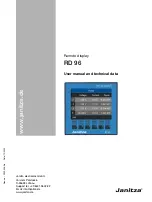
RUGGEDCOM ROX II
User Guide
Chapter 5
Setup and Configuration
PIM-SM Concepts
555
•
Section 5.24.6, “Managing a Boot Strap Router”
•
Section 5.24.7, “Viewing the Status of PIM-SM”
•
Section 5.24.8, “Viewing the Status of Dynamic Multicast Routing”
Section 5.24.1
PIM-SM Concepts
When a PIM router receives a subscription from a host, e.g. Host A, for particular multicast traffic, the directly
attached designated router (DR) sends a PIM join message for this multicast group towards the rendezvous point
(RP). The message is sent hop-by-hop and thus any routers encountering the message would register the group
and send the message onwards towards the RP. This would create the shared tree (RP-tree). The tree will not be
complete, however, until any sources appear.
When a host or device sends multicast traffic destined to the multicast group subscribed by A, the directly
attached designated router takes the traffic, encapsulates it with PIM Register headers and unicasts them
to the RP. When the RP receives this traffic, it decapsulates the packets and sends the data towards the
subscriber through the RP tree. The routers that receive these packets simply pass them on over the RP-Tree
until it reaches the subscriber. Note that there may be other subscribers in the network and the path to those
subscribers from the RP is also part of the RP Tree.
After the shared tree has been established, the traffic flows from the source to the RP to the receiver. There
are two inefficiencies in this process. One, the traffic is encapsulated at the source and decapsulated at the RP,
which may be a performance penalty for a high level of traffic. Two, the traffic may be taking a longer path than
necessary to reach its receivers.
After the shared tree has been established, the RP may choose to to send a Join message to the source
declaring that it only wants traffic for a group (e.g. group G) from the source (e.g. source S). The DR for the
source then starts sending the traffic in multicast form (instead of unicast). Without encapsulation, there is little
performance overhead other than what is normal for the traffic when routing in general. The RP will continue
sending the traffic over the RP-tree after it receives it. This also means that the traffic may reach the RP-tree
before it reaches the RP (in the case where the source branches off the RP-tree itself) which will also have the
additional benefit of traffic flowing more efficiently towards receivers that are on the same side of the RP-tree as
the source.
If the DR to the receiver decided that traffic coming from the RP-tree was using a suboptimal path than if it was
received from the source itself, it would issue a source-specific Join message towards the source. This would
then make all intermediate routers register the Join message and then traffic would start flowing along that tree.
This is the shortest path tree (SP-tree). At this point, the receiver would receive the traffic from both the RP-tree
and the SP-tree. After the flow starts from the SP-tree, the DR will drop the packets from the RP-tree and send a
prune message for that traffic towards the RP. This will stop the traffic from arriving from the RP. This scenario will
most likely only occur when the traffic has to take a detour when arriving from the RP. Otherwise the RP-tree itself
is used.
Section 5.24.2
Configuring PIM-SM
PIM-SM can be used to establish and dynamically manage the Multicast Routing table.
To configure PIM-SM, do the following:
1. Change the mode to
Edit Private
or
Edit Exclusive
.
2. Navigate to
routing
»
multicast
»
dynamic
»
PIM-SM
. The
PIM-SM Configuration
form appears.
Содержание RUGGEDCOM RX1510
Страница 32: ...RUGGEDCOM ROX II User Guide Preface Customer Support xxxii ...
Страница 44: ...RUGGEDCOM ROX II User Guide Chapter 1 Introduction User Permissions 12 ...
Страница 62: ...RUGGEDCOM ROX II User Guide Chapter 2 Using ROX II Using the Command Line Interface 30 ...
Страница 268: ...RUGGEDCOM ROX II User Guide Chapter 4 System Administration Deleting a Scheduled Job 236 ...
Страница 852: ...RUGGEDCOM ROX II User Guide Chapter 5 Setup and Configuration Enabling Disabling an LDP Interface 820 ...
















































